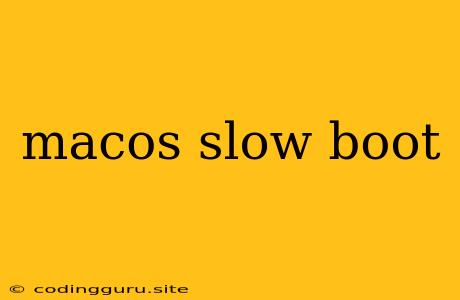Is Your Mac Taking Forever to Boot?
A slow boot time on your Mac can be incredibly frustrating. You're eager to get to work, but instead, you're staring at a spinning beach ball, waiting for your computer to finally wake up. But fear not, there are several things you can do to speed up your Mac's boot time.
Why Is My Mac So Slow to Boot?
Several factors can contribute to a slow boot time on your Mac. Here are some of the most common culprits:
- Too Many Login Items: Login items are applications and services that automatically launch when you start your Mac. If you have too many login items, they can significantly impact your boot time.
- Startup Disk Issues: A cluttered or fragmented startup disk can slow down your boot process.
- Background Processes: Numerous programs might be running in the background, consuming resources and slowing down your boot process.
- Hardware Issues: If your Mac's hardware is getting old or is experiencing issues, it might be contributing to the slow boot.
- Software Issues: Corrupted software, outdated drivers, or conflicting applications can all cause boot problems.
- Outdated macOS Version: Outdated macOS versions can sometimes cause performance issues, including slow boot times.
How to Fix a Slow Mac Boot Time
Here's a step-by-step guide to troubleshoot and fix slow boot times on your Mac:
1. Identify and Manage Login Items
- Open System Preferences: Click the Apple icon in the top left corner and select "System Preferences."
- Go to Users & Groups: Select "Users & Groups" from the System Preferences window.
- Click "Login Items" tab: You'll see a list of applications and services that launch automatically when you start your Mac.
- Disable Unnecessary Items: To disable an item, uncheck the box next to it.
2. Optimize Your Startup Disk
- Run Disk Utility: Open the Spotlight search (Command + Space) and type "Disk Utility" and press Enter.
- Select Your Startup Disk: In the left sidebar, select your startup disk (usually named "Macintosh HD").
- Click "First Aid": This will check your disk for errors and attempt to repair them.
3. Clean Up Your Mac
- Delete Unnecessary Files: Get rid of unused applications, downloads, and large files to free up space on your hard drive. You can use the "Finder" to locate these files or use a third-party cleaning application.
- Empty Trash: Make sure you regularly empty your trash bin to prevent it from accumulating unnecessary files.
4. Manage Background Processes
- Use Activity Monitor: Open Activity Monitor by searching for it in Spotlight. This will show you all the processes running on your Mac.
- Identify Resource-Hungry Processes: Look for processes that are using a lot of CPU or memory, and you may want to quit them.
5. Check for Software Issues
- Run a Disk Repair: As mentioned above, using Disk Utility's "First Aid" feature can help repair errors and ensure your disk is healthy.
- Update Software: Make sure your macOS is up to date and that all your applications are using the latest versions.
- Reinstall macOS: If all else fails, reinstalling macOS can help resolve software issues and potentially improve performance.
6. Update Your Drivers
- Check for Updates: Make sure your drivers are up to date by visiting the manufacturer's website for your computer's hardware, such as your graphics card or network card.
7. Consider Hardware Upgrades
- Upgrade RAM: Adding more RAM can help improve performance for many tasks, including booting up.
- Upgrade Storage: Switching to an SSD (Solid State Drive) can significantly speed up your Mac's boot time and overall performance.
8. Reset the SMC (System Management Controller)
- Power off your Mac: Turn off your Mac completely.
- Press and hold the following keys: Shift + Control + Option + Power button for 10 seconds.
- Release the keys and power on your Mac. Resetting the SMC can help resolve various hardware-related issues, including boot problems.
9. Reset the PRAM (Parameter RAM)
- Power off your Mac: Turn off your Mac completely.
- Press and hold the following keys: Option + Command + P + R.
- Release the keys when you hear the startup chime for the second time. This resets your PRAM, which can sometimes help resolve boot problems.
10. Use Startup Disk Utility:
- Boot into Recovery Mode: Hold down the Command + R keys while starting your Mac to boot into Recovery Mode.
- Select "Disk Utility": From the Recovery Mode menu, select "Disk Utility."
- Repair Disk: Run Disk Utility's "First Aid" feature to check and repair your startup disk.
Conclusion:
A slow boot time on your Mac can be frustrating, but it's often a problem you can solve. By following these steps, you can identify and address the root cause of your slow boot and get your Mac back up to speed. Remember to be patient and try each step carefully, and you'll hopefully be back to enjoying a smooth and fast boot experience in no time!
